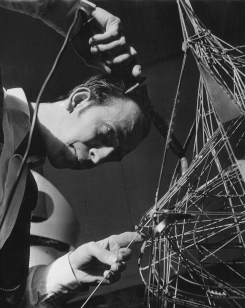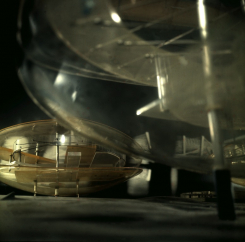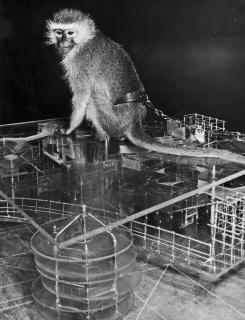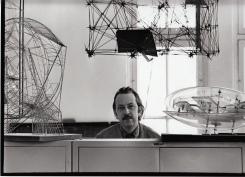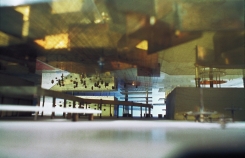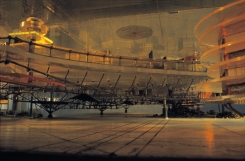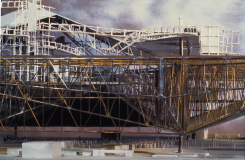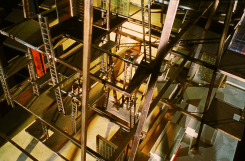Image

After he leaves the SI Constant Nieuwenhuys continues to work on his New Babylon project. Inspired by the book Homo Ludens by Johan Huizinga he designs models for cities with the playful and creative human being at the center. Cities in which man is liberated from manual labor, where man can dedicate himself fully to the development of creative ideas. He focuses on the question which role art plays in intensifying a daily life filled with creative expression? He abandons painting to dedicate himself fully to the New Babylon project. He works on the project from approximately 1956 to the New Babylon exhibition in 1974.
With New Babylon he creates a vision of a worldwide network of connected cities of the future. Land is collectively owned and labor fully automated. The need to work is replaced by a nomadic lifestyle of creative play. New Babylon is inhabited by homo ludens, who liberated from labor, has no need for art because he can be creative in his daily life. In Constant's own words: New Babylon offers only minimal conditions for a behaviour that should remain as free as possible. Every limitation of movement, of the creation of mood and atmosphere should be inhibited. Everything should remain possible, everything should be able to happen. The environment is created by the activities of life not the other way around.
With the help of assistants Constant produces models of plexiglass, stainless steel, aluminum, iron wire and wood. The models stretch out over geographical maps of the Netherlands, Europe and the world in connected sectors. The project encompasses models, constructions, paintings, drawings, collages, litho's, texts, readings and films. Constant doesn't merely consider New Babylon a design for a futuristic city but as "a design for a new culture". To finance the project he sells his collection of Cobra paintings.
In 1974 the New Babylon project is officially completed with a large overview exhibition in the Gemeentemuseum The Hague. Since Constant had no room to store all the models and constructions he sells the bulk to the museum. In a lecture on May 23rd, 1980 at Delft University Constant says the following on the completion of his New Babylon project:
'... we kunnen ons een tamelijk duidelijke voorstelling maken van een nog onbewoonde wereld. Moeilijker wordt het deze wereld te bevolken met mensen die zo totaal anders zijn dan wijzelf: we kunnen hun ludieke of inventieve gedrag niet vooraf bepalen noch ontwerpen. We kunnen slechts een beroep doen op de fantasie en van de wetenschap op de kunst overgaan. Dit inzicht heeft mij ertoe gebracht het werk aan de maquettes te staken om in schilderijen en tekeningen te trachten, hoe globaal ook, enig newbabylonisch leven te wekken.
Verder kon ik niet gaan. Het project bestaat. Het ligt, goed opgeborgen in een museum, te wachten op gunstiger tijden waarin het opnieuw interesse zal wekken van toekomstige stedenbouwers.'
'... it is possible to form a fairly clear idea of an as yet uninhabited world. It is more difficult to populate this world with people who live so very differently from ourselves: we can neither dictate nor design their playful or inventive behavior in advance. We can only invoke our fantasy and switch from science to art. It was this insight that prompted me to stop work on the models and to attempt in paintings and drawings, however approximately, to create some New Babylonian life.
This was as far as I could go. The project exists. It is safely stored away in a museum, waiting for more favorable times when it will once again arouse interest among future urban designers.'
In 1999 the exhibition, Constant's New Babylon: City for Another Life, opens at the Drawing Center in New York. It's Constant first solo exhibition in the United States. The exhibition is curated by Mark Wigley. The exhibition is followed by a catalogue and symposium, titled The Activist Drawing: Retracing Situationist Architectures from Constant’s New Babylon to Beyond.
According to architect Rem Koolhaas, New Babylon provided some serious food for thought to many architects: "He was an example of courage."
Early Period 1920-1947
CoBrA 1948-1951
Towards a Synthesis of Art 1952-1956
New Babylon 1956-1974
Situationist International 1958-1960
Late Period 1974-2005


